How to Mill Grains At Home: KitchenAid vs. Mockmill
We love grinding grains at home. Here, I am sharing my experience with the KitchenAid and Mockmill grain mill attachments.
Grinding grains at home is much better than buying whole-grain flours.
While there are so many different ways you can grind your own flours, I wanted to share why I love my KitchenAid stand mixer and what attachment I prefer for that!
This post contains affiliate links, which means I make a small commission at no extra cost to you. You can read my full disclosure.
Why grind grains at home?
Of course, you can choose to buy whole grain flour. Or simply buy a whole grain product such as bread, bagels, cakes, muffins, or pasta.
While I am not certain about whole grain flours, I did learn a thing or two about whole grain products you can buy in the store.
A grain consists of the bran (the fiber), the germ, and the endosperm (the starch that is your flour). Since the germ contains oils, it can go rancid easily and quickly. Therefore, commercial food producers often, if not always separate all the parts of the whole grain but only add back the bran and the flour. Then, you are not getting a true WHOLE grain product. I don’t know about you but I found that pretty disturbing!
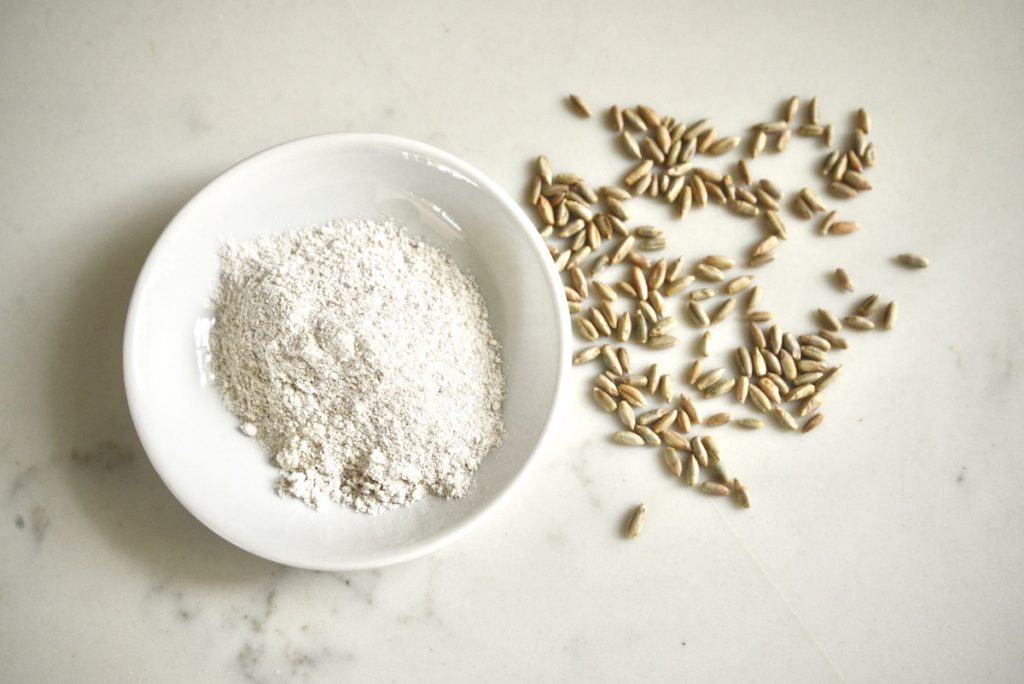
Why grind your own grains?
We like to bake our own breads and other flour-based goods.
I bake several times a week, both a darker, denser European-style whole-grain bread and a lighter artisan-style sourdough bread. The former is a true whole grain bread while the latter is white flour-based with some whole grain flour added for taste and better texture.
If you have never smelled the smell of freshly ground flour, you are in for a treat. But more importantly, grinding grains at home and immediately baking your bread (or using it) retains all the vital nutrients!
With the oils in the germ, whole grain flour can go rancid pretty quickly. So if you’re not using your freshly milled four right away, it is recommended to store it in the fridge for a day or two or better freeze for longer storage.
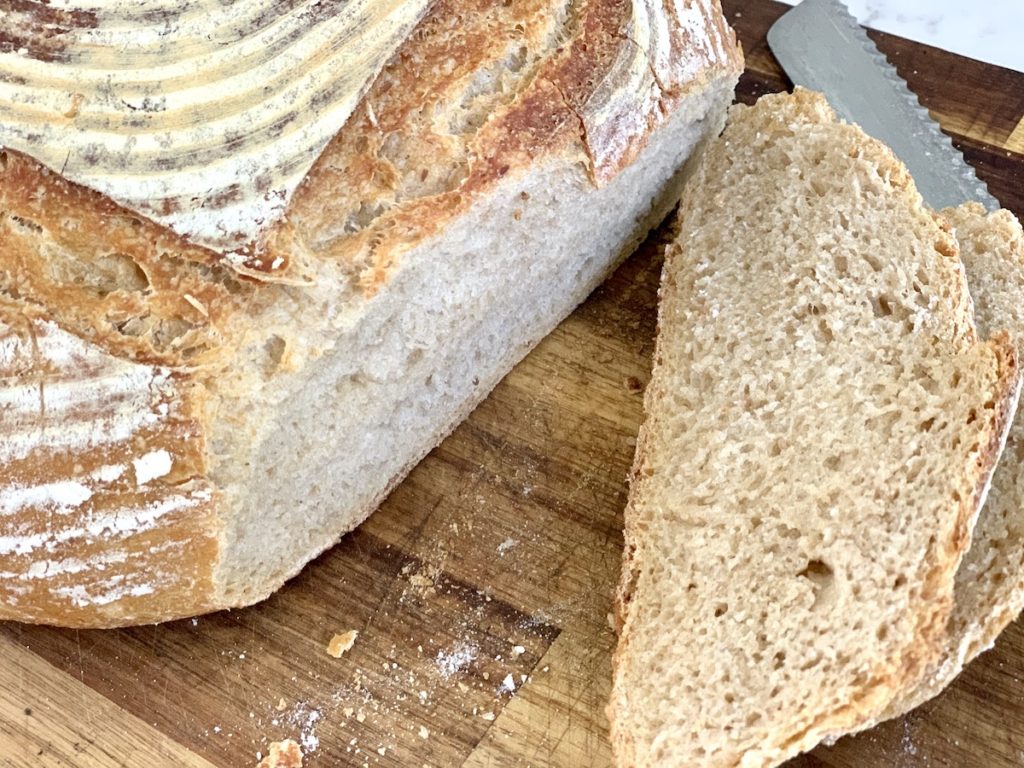
The KitchenAid grain mill attachment
I had enjoyed my KitchenAid grain mill attachment for some 17 years or so and it had been working well enough for me.
What I loved most about this attachment is that I can use my trusty old KitchenAid stand mixer instead of having a single-purpose appliance (a dedicated grain mill).
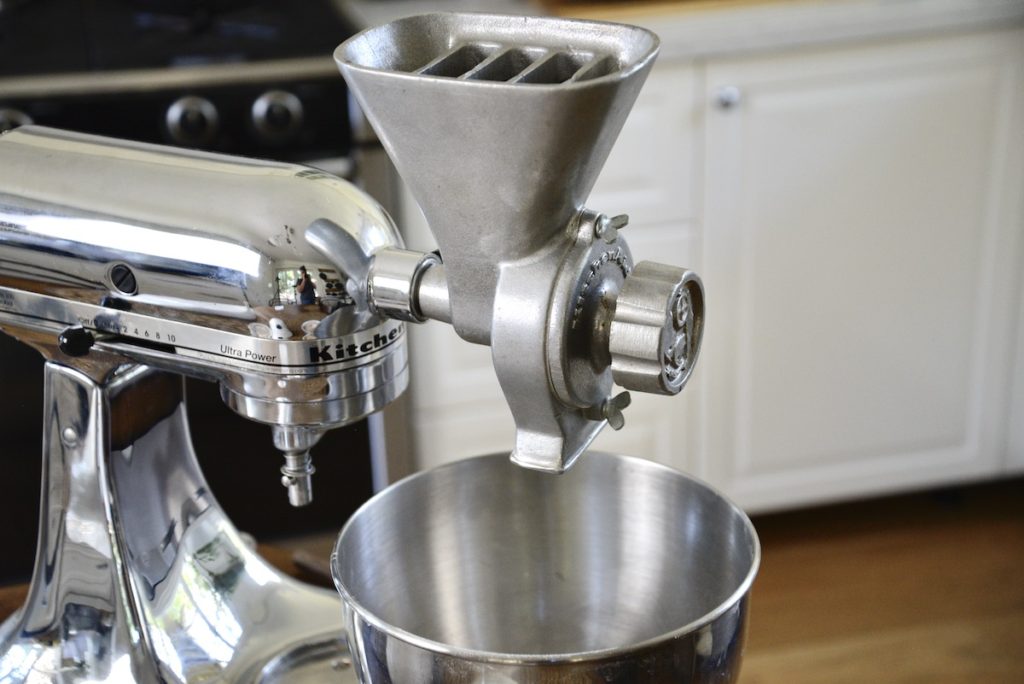
You see, for my German whole grain bread, I mill a pretty coarse flour.
But more recently, I have been wanting to and needed to grind grains to a very fine flour. I was shocked to notice how hot the flour had become from the friction of the grinding stones.
So I did some research and come across this:
The Mockmill grain mill attachment
Yes, there is another KitchenAid stand mixer grain mill attachment called the Mockmill. For clarity, I want to mention that this is NOT a sponsored post!
I am merely sharing my own opinion and my excitement over something that works really well!
This Mockmill attachment is Made in Germany – which is usually a good sign and makes this German girl very happy.
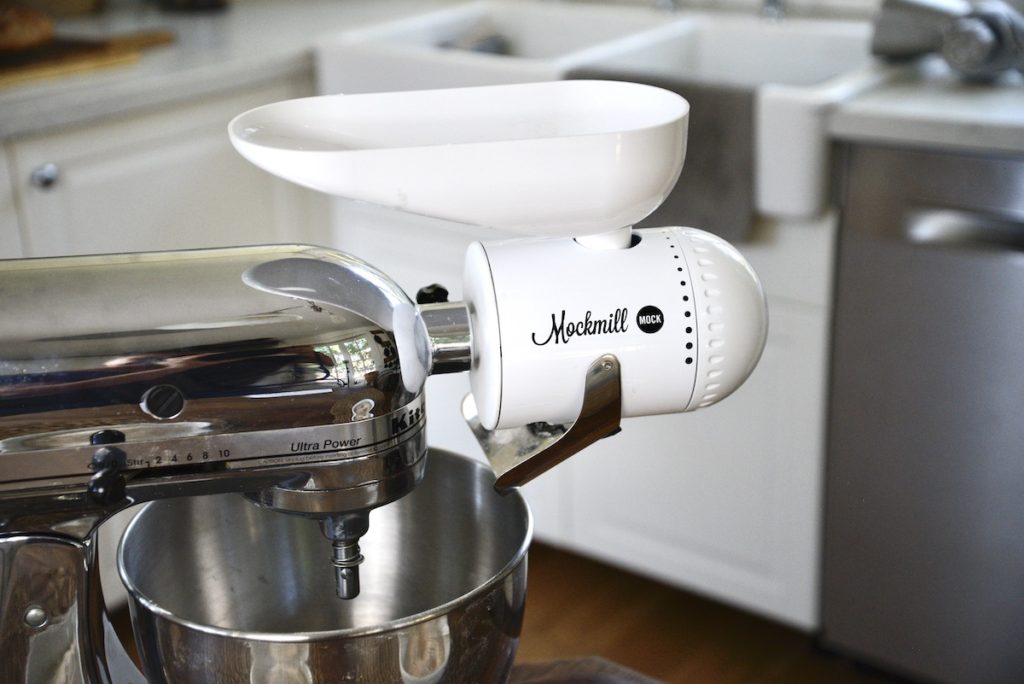
Similarities between the 2 attachments
The concept is the same for both of these: they attach to the front of the KitchenAid stand mixer. You pour the grains into the top or the hopper, turn the mixer on, and adjust the coarseness or fineness of the flour as needed while the machine is on.
Differences between the Mockmill and the Kitchenaid grain mill attachments
While the KitchenAid grain mill attachment is a single piece, the Mockmill attachment consists of the hopper, the actual grinding mechanism, and the chute.
That being said, the way these grain mills attach to the mixer, with the Mockmill, you can leave the bowl where it is. With the KitchenAid grain mill, you need to take it out and place it in front of the KitchenAid.
My absolute main reason for switching from something that works well is this: when I was grinding flour on the finest setting with the KitchenAid grain mill, the flour came out so hot, it felt as if it was being cooked. You might be able to grind a small amount of flour without it getting very hot. But once you want to grind a few cups at a time, the flour just gets too hot.
Again, I am not saying the KitchenAid grain mill attachment is bad! It is a fine choice for someone who grinds smaller amounts of flour, doesn’t grind flour very often, and/or doesn’t need to grind very fine flour.
The Mockmill attachment on the other hand, on the same setting, does warm the flour a bit but not nearly as hot as the KitchenAid attachment.
When looking at how finely ground the flours come out, the Mockmill does a much better job. The flour is so much finer than the one ground with the KitchenAid grinder attachment. When I set the dial to the finest setting on the KitchenAid attachment, the stand mixer started making a worrisome sound toward the end. I have never blown out my stand mixer and certainly don’t want to risk that!
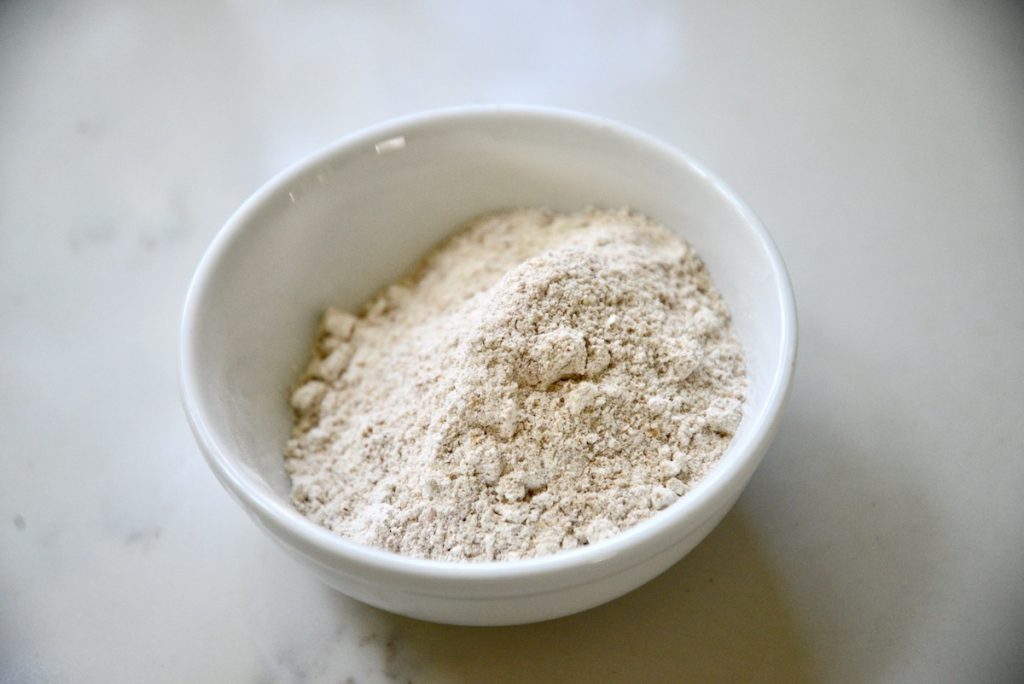
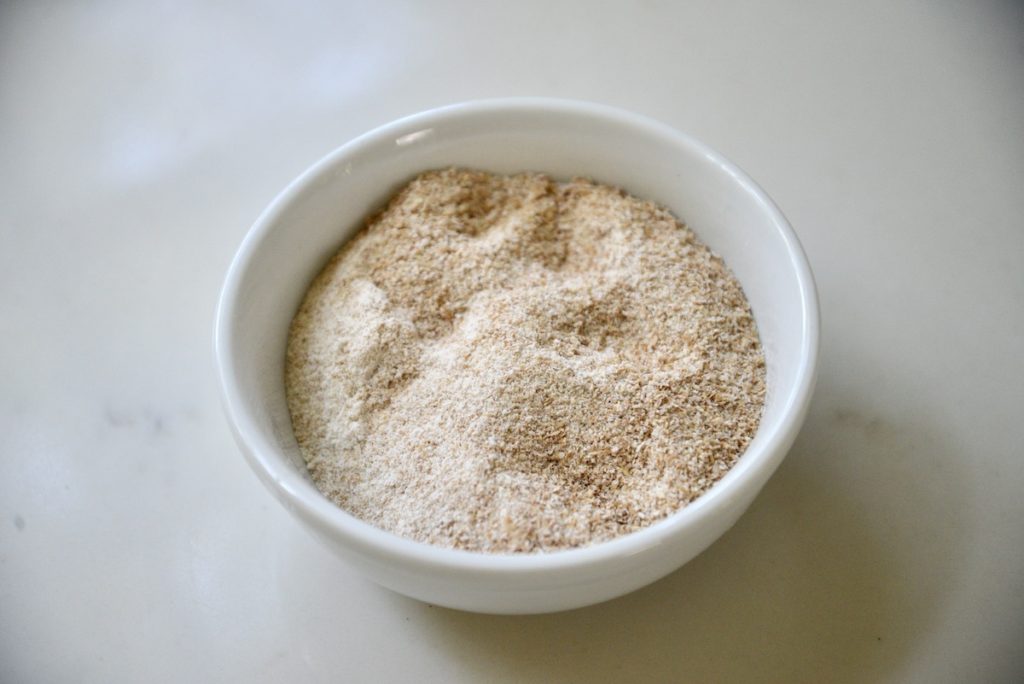
And since I am grinding a lot of flour several times a week, I chose to get the Mockmill grain mill attachment.
Prices and availabilities of both grain mill attachments
As both of these are attachments don’t need their own motor, I find them reasonably priced. The KitchenAid attachment is about $150 and the Mockmill attachment is about $200 (you can buy it here with a 5% discount).
If you’re reading this post at the time of publication (July 2020), you might not be able to find either one. Everyone is baking bread at home and everyone seems to be grinding their own flour so both attachments might be sold out or on back-order.
I am giving you some vendors but it might be worth checking back periodically, whether one or the other grain mill attachment is back in stock.
Other ways to grind flour at home
There are a lot of stand-alone grain mills on the market. However, going into those would be a whole different post altogether. Mockmill also makes several other very high-quality dedicated grain mills.
If you don’t own a KitchenAid and/or if you don’t want to invest in a dedicated grain mill, you could use a high-speed blender such as a Vitamix or Blendtec. These work for smaller amounts of grains or if you only want to grind flour occasionally. Here, too, I find that the flour just gets too hot. But in a pinch, a high-speed blender can be a reasonable choice.
Sources and links:
KitchenAid grain mill attachment
Mockmill KitchenAid grain mill attachment
Let me know if you have comments or questions!
Pin For Later:
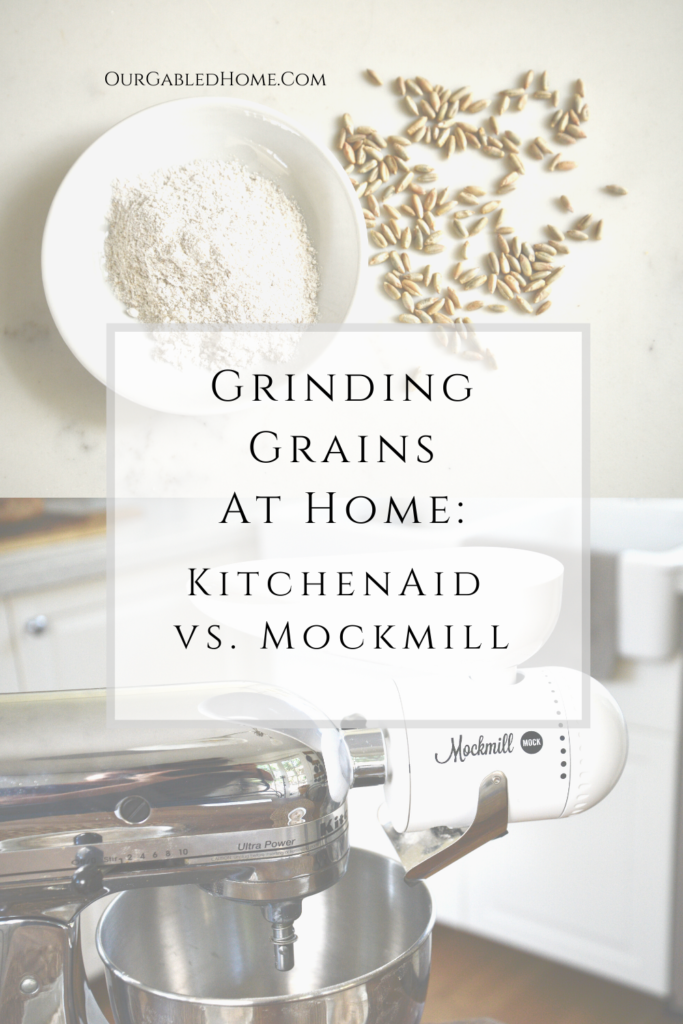


Why would you not have a dedicated milling machine if you grind a lot of flour every week. Kind of negates the legitimacy of this entire article not to mention it’s kind of shady that you offer a 5% discount on the mockmill.
In our old kitchen, we didn’t have a lot of space but since our remodel I have upgraded to the Mockmill Lino 200. I am a certified reseller which you can easily verify with Mockmill US ~ Anja
I’m interested in the mockmill attachment, do you know if you can make flour as fine as 00? I make a lot of pasta and pizza dough and use 00 for those recipes. Thank you:)
You may find this thread helpful: https://forum.breadtopia.com/t/mockmill-pizza-crust/18590/3
This was exactly the comparison I was searching for — am ordering a Mockmill today. Thanks so much!
I am so glad you found this helpful!!
I would really love to read this article, but I can’t because the ads continue to bounce me all over the page.
I am so sorry for your experience. Maybe you’d like to watch the video: https://www.youtube.com/watch?v=MEfI60q73Yw&t=771s Let me know if you have more questions ~ Anja
Thank you for the great post! You answered the very questions I have been attempting to get answers to with little results. Glad I found yours!
Thanks for a wonderful review. I am considering either getting the mockmilll kitchen aid attachment or a stand alone mill. I had a couple questions; hopefully you can share your experience with me!
Firstly, how warm does the flour get if you are using speed 2 (lowest)? Also, how long to grind 2 cups of flour on this setting? I think i have a similar kitchenaid model as you – Artisan, 325watt motor – will this motor heat up to the point of needing to cool while using this grinder? How long can you run the mill before that happens in your estimation? We are not cooking for the Russian army in my household, but I would like to know if I can reasonably grind 2 cups of flour in one go at a low temperature.
Danke Schoen!
Hi there, thank you for reaching out! Honestly, I don’t know how warm the flour gets but it is definitely very minor on the slowest speed. I have never ground to the point of having to turn it off to let it cool down but with the KitchenAid attachment, the flour did get hot after a while (I used to grind about 5 cups of flour at a time). I think you will be fine with grinding 2 cups at a time. Hope this helps 💛 ~ Anja
Great post! I think I’ll look into the mock mill if I’m ever in the market for a kitchen aid mixer grain mill. I currently have a hand crank grain mill but I haven’t gotten to the point of grinding my own flour yet.
Thanks for sharing I am super new to grinding my own grains, do you think it matters to use metal verses a stone mill ?
I personally think it’s most important that the grinding stones don’t get too hot – no matter what material. Having said that, the Mockmill uses ceramic and I really like it!
I always wondered how this was done! Very neat!
Thank you! So glad you enjoyed it!
Great information! It definitely sounds like Mockmill is the way to go! I looked into this attachment but worried it might burn out my Kitchenaid motor. I will have to consider it again.
Yes! I have been grinding grains for almost 20 years with my KitchenAid and never had a problem.
I am still considering the KitchenAid grinder. During your seventeen years of using it, were you able to make all the flours you wanted to use, including flour as fine as all-purpose?
And which types of flour were you unable to make with it?
Great post, BTW. Great site, for that matter! Thanks!
Yes, I was able to make all sorts of flour but again, the KitchenAid grain mill uses steel rollers and heats up the flour ~ Anja